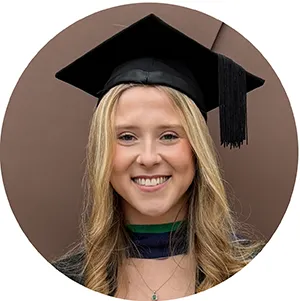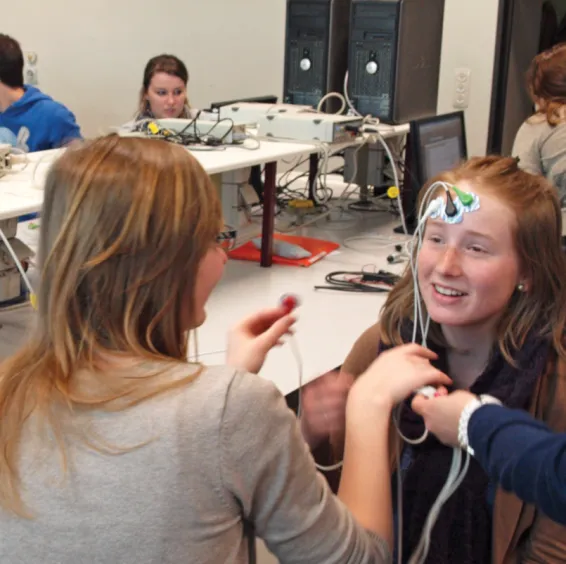A successful Medical Science graduate of Flinders University, Hannah Gapps now works as a Technical Officer in pathology.

She used Lt in her practical physiology labs while studying, and chatted to us about how the interactive platform helped her learn.
Hannah had always been interested in medicine, and during her undergraduate degree found that she had a passion for hands-on science.
She shares, “In my third year, laboratory medicine came up as a course at my university, so I transferred, and I've come out really enjoying the hands-on lab work.” Her current role in pathology labs in South Australia lets her combine this practical work with patient care through pathological testing.
Providing a framework in the unknown
Hannah began using Lt and PowerLab for human physiology practicals in her first year at Flinders University. Her student cohort was new to data collection and she had never done anything like these hands-on practicals before. In her other labs, they were doing “manual lab work [like] pipetting and streak plating rather than anything that would require software.”
She says, “At first, we didn't really know what to expect for a physiology lab. We were kind of expecting to go in and use stethoscopes! But then there were all these fancy machines [PowerLab] that we got to hook up to.”
"I think it gave us a more in-depth understanding, because everyone was able to then practice a reflex response or check their pulses, and we got accurate readings rather than just trying to figure it out."
"It was a completely new experience."
Understanding physiological variability with real data
The class used PowerLab to measure a range of physiological variables including ECG, pulse, reflex latency and amplitude, and respiratory rate.
Something that Hannah found particularly useful was the exposure to real data: “I remember particularly that the ECG recording was our first time looking at those types of graphs, and because everyone had different heart rates, it would change. So it's interesting because it wasn't your perfect, ‘textbook’ ECG. It gave us an understanding of what you would expect if you were to go toward [the medical] field.”
"Lt helped from a data gathering and interpreting perspective, and allowed for team discussion, investigation into results, and a problem-solving approach if results were not as expected."
Related: Human Physiology Collection in Lt »
Seeing abstract concepts in real life
An important part of these labs was linking the abstract theory that Hannah was learning in her lectures with practical outcomes in the lab. Reflecting, she says, “We liked being able to see a graph be produced of what we were doing. To actually understand the rate of a reflex, understand how the heart rate works, how exercise affects your spirometry [data]. Actually seeing that on a graph visualized what was going on in the body.”
"It definitely helped link [theory and practice] together."
Ultimately, Lt made it easier for the students to understand those key ideas in physiology. Hannah says, “You can be told, ‘This is how a reflex works,’ and that's all great."
"But then you're not really sure what's actually happening until you're practicing how to do a reflex test on someone. And then seeing the actual nerve response and muscle response on a graph and how that can change between different people. And if you add a muscular disorder in there, how that changes as well.”

Students get hands-on with hardware in the lab to record authentic data.
Combining this live data recording with videos meant that students were supported throughout the lab: “There would be videos on how to set up the equipment, how to perform the test, telling us how long we needed to run the test for. There were very clear, step-by-step, instructions on how to perform each practical that we needed to do.”
Building soft skills and tech literacy
We know now that soft skills are extremely important for STEM graduates. Hannah found that Lt helped build teamwork when collecting data - one student was the volunteer, one student recorded the data, and one student conducted the experiment.
“It absolutely had an impact on teamwork, because for these practicals [we were] usually in a group of 2 to 4 people. So we're all working together to interpret results. You learn your roles and how to switch around, and you would go with a different group each time. So you knew you weren't getting the same results constantly, and there was no bias in your reports.”
Revisiting practicals for exam revision
One useful feature of the course for Hannah and her peers was the fact that Lt remained available throughout the semester. They could revisit the results and answers they generated during their practicals and use this for revision.
Hannah says, “Seeing the responses helped when it came toward exam time, because we could go back and reflect on our practical data prior to the exam.”
Hannah’s recommendations for educators
1. Provide example data
Although most Lt human physiology labs come with example data, in Hannah’s practicals example data weren’t made available. This made things tricky if they needed to understand a specific phenomenon or if their data quality was poor - as is common in first-year labs.
Hannah says, “If the data we produced didn’t match the desired outcome, then we would try and redo the data by finding someone else in the class that we could use. But if we couldn't, then that would be a problem.”
Solve this problem by supplying example data in your Lt labs with a single click. Learn how in the short video below »
2. Make sure questions are relevant to the subject
If you’re creating your own questions for labs, make sure they are directly related to the practical students will complete that day. Hannah found some difficulty with unrelated questions during labs and pre-labs: “Some of the questions would not be related to the actual practical itself.” You can easily edit any of the content in Lt's ready-made lessons to suit your lab curriculum.
Related: Tips for educators: How to write multiple-choice questions »
3. Be comfortable with the software
Although Lt helped the students themselves become more comfortable with technology and scientific hardware like PowerLab, Hannah recommends that educators take the time before class starts to deep-dive into the software they will be using with students.
“We have four topics a semester, and they could all have different software. So for us to try and learn all four, we need a teacher who can guide us in the right way, and know how to troubleshoot.”
“The biggest thing is teachers understanding what they're putting forward - before anyone else uses it, they need to know how to use it.”
Reflecting on her experience, Hannah sums it up: “You can read a textbook as much as you like, and get all the pretty pictures. But you're not gonna truly understand the complete function until you're looking at various results [in Lt] from a patient population within the lab.”
Would Hannah be likely to recommend Lt to other physiology students? She says, "Very likely. In physiology labs, it provides a visual response to learn and understand the internal response."
"We know everyone breathes; we know exercise and respiratory conditions can affect an individual's breathing; and we know by using the textbook how to look for a ‘wheeze’. But when you do a spirometer test using Lt you can see - graphed - how everyone’s intake is different and how asthma, anxiety etc can alter the data."
Ultimately, Hannah aims to become a senior medical scientist and return to the university where it all began. At Flinders, she hopes to provide what she has learned to the next generation of scientists and clinicians.
Enjoyed this story? Discover more student experiences: What’s it like to use Lt as a student? “Great fun…the hands-on side of it really accelerates the learning.”

Hannah Gapps,
Technical Officer,
SA Pathology.
A passionate Technical Officer in Pathology in South Australia, Hannah graduated from Flinders University with a Bachelor of Medical Science (Laboratory Medicine) and a GPA of 6+. During her time there, she used Lt and PowerLab to study physiology in practical labs. You can find Hannah on LinkedIn.


